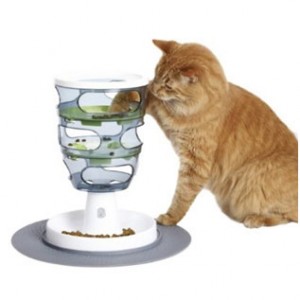Hobo, one of our clinic cats, started life on the streets and he has never forgotten what it feels like to be hungry. Food is precious to him. He thinks about it constantly and if left to his own devices, he would seriously over eat. Like many pets he “lives to eat” as opposed to “eating to live”.
At Sault Ste. Marie, we know that obesity is a leading cause of serious health problems pets. We love our little Hobo and want to do everything we can to keep him healthy so we keep him on a very strict diet to try and keep him at a healthy weight. It’s not always easy but here are some tips and tricks we have found useful in helping Hobo battle the bulge:
1. Use a prescription diet food. Many pet foods are very, very calorie dense and most pets (especially indoor cats) are not physically active. A prescription weight loss diet will have a significantly reduced calorie density allowing you to feed your pet and leaving them feeling more sated. Prescription weight loss foods will also have optimum levels of nutrients, fiber and extras like L-carnitine which helps your pet to lose fat but retain muscle. In other words, when being fed a prescription weight loss food, your pet will still get the optimum levels of important nutrients and vitamins and minerals while consuming fewer total calories.

2. Feed a combination of canned and dry food. Canned food has a much higher water content so it is more filling and less calorie dense than dry food. Some dry food is good to help keep teeth clean.
3. Measure the amount of food fed! When pet food packaging gives the amount to feed in cups, it is referring to actual measuring cups….not oversized coffee mugs or margarine containers. Using a kitchen scale is an even more accurate way to determine how much you are actually feeding your pet.
4. Divide feeding time up into smaller more frequent meals. For many pets and owners, feeding time is a time of pleasant interaction and contact….cats especially will often enjoy the social interaction involved with getting small frequent meals throughout the day. One way of doing this is to measure the total amount of dry food your cat is to get for the entire day into a measuring cup and place it in a cupboard. You can then dispense small amount throughout the day but when the measuring cup is empty, that’s it until the next day!
5. Make your pet work for his or her food. There are many toys/food dispensers available on the market that your pet must play with or push around to get the dry kibble out of. This makes mealtime last longer and provides valuable mental stimulation for your pet without adding extra calories. You can even make your own food dispenser….Hobo uses an old cardboard tea container with a couple of holes punched in it.



7. Limit treats and no table food. Just like in people, diets only work if you follow them. Even the best quality weight loss diet will not work if your pet is getting lots of treats and table food! Feed only calorie controlled treats and figure them into your pet’s total calorie consumption for the day. Even though Hobo would gladly help take care of the food left over by our hospitalized patients, he is not allowed to have it. He does however know where the treat jar is will gladly point it out to visiting clients.6. Weigh your pet to track progress. Frequent “weigh ins” will help you keep track of your pet’s progress. Pets should be weighed once weekly for the first few weeks of a diet to make sure that weight loss is not too rapid then once a safe rate of weight loss has been established, they should be weighed at least once a month. It is a good idea if “weigh ins” are done at the clinic; on the walk on scale in the waiting room for larger dogs and on our small scale (which are more accurate for smaller fluctuations in weight) for smaller dogs and cats. There is no charge for this service and we like to keep a record of your pet’s weight loss in their file. Many people bring the pet along when they are buying food and have them hop on the scale. Just give us a call and we will let you know when is a good time to bring your pet in to be weighed.
8. Take a “hands on approach” to your pet’s weight. Remember, all that hair can hide a pet that is either seriously underweight or seriously overweight. You should be able to feel your pet’s ribs and spine by applying very light pressure with your fingertips…..if you can’t feel them easily, your pet is probably overweight. If the bones are too prominent, your pet might be underweight. Get to know how your pet feels normally…..any unexplained changes warrant a check- up. Get to know your pet’s BCS (Body Condition Score)

9. Exercise is key! Once again, just like people, adequate exercise helps to control body weight. For dogs, regular leash walks are good for both owner and pet. Most dogs love to engage more vigorous activity such as games of fetch, agility class, fly ball, swimming and playing with other dogs. For indoor cats, scheduling regular exercise can be a little more challenging. Toys like laser lights and balls can get them moving. Sometimes even something as simple as putting the litter pan in the basement and the food dish on the top floor will encourage more physical activity throughout the day. One of Hobo’s favorite ways to get exercise is to chase after kibble that is thrown down a long hallway….he can move surprisingly quickly after a bouncing piece of kibble! These days, Oscar helps keep Hobo fit by instigating lots of rough and tumble play.
10. Please check with us before starting your pet on a weight loss program. Just like in people, slow, steady weight loss is safer and healthier than rapid and dramatic weight loss. In cats, sudden, severe calorie restriction can actually cause serious liver disease. If you think your pet might need to lose some weight, please call to schedule an appointment. Together, we will design a safe and effective weight loss program for them.
